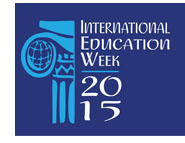| November 16, 2015
|
Special IIE.Interactive |
|
|
|
All of us at the Institute of International Education
express our solidarity with the people of France and Lebanon and our
condolences to those who have suffered loss. Our thoughts are with the people
of Paris and Beirut and all those around the world who have been affected by
the attacks.
 Today, the Institute of International Education (IIE), together with the U.S. Department of State's Bureau of Educational and Cultural Affairs, released the latest news on international students in the United States and U.S. students studying abroad. The Open Doors® findings will also be a topic of a briefing this morning, at the National Press Club in Washington, DC, with Assistant Secretary of State Evan M. Ryan and IIE President Allan E. Goodman, in conjunction with the worldwide observance of International Education Week.
We expect to see press coverage in major news outlets in the United States and around the world beginning today and throughout the week.
To access the new data and background information to help explain the trends, go to www.iie.org/opendoors.
We encourage you to share this information with the press office on your campus and to work with them to publicize your institution's success in hosting international students and sending your students to study abroad. You can localize the story by providing details about the students coming to and going from your campus, such as where they come from, where they go, what they study, and what effect this has on your campus and community.
The print publication will be available in February 2016. At that time a free complimentary print copy of Open Doors 2015 will be sent to the survey respondent on each campus who provided data on international student flows, and to the international student designee of IIENetwork member campuses, as a benefit of your IIENetwork membership. If you are unsure of your IIENetwork membership status, please contact membership@iie.org.
HIGHLIGHTS:
 NEARLY ONE MILLION INTERNATIONAL STUDENTS ARE ON U.S. CAMPUSES; HIGHEST RATE OF GROWTH IN 35-YEARS NEARLY ONE MILLION INTERNATIONAL STUDENTS ARE ON U.S. CAMPUSES; HIGHEST RATE OF GROWTH IN 35-YEARS
- The number of international students at colleges and universities in the United States increased by 10 percent to a record high of 974,926 students in the 2014/15 academic year, confirming once again that the United States remains the destination of choice for higher education.
- The United States hosts more of the world’s 4.5 million globally mobile college and university students than any other country in the world, with almost double the number hosted by the United Kingdom, the second leading host country. Increases in international student enrollment were reported in forty-four states in 2014/15.
- Top 5 countries of origin: China, India, South Korea, Saudi Arabia, Canada.
- India’s growth outpaced China’s this year, with students from India increasing by 29.4 percent to a record high of 132,888. This is the highest rate of growth for Indian students in the history of the Open Doors project, which spans back to 1954/55. The last time India grew at a comparable rate (29.1) was in 2000/01 when the number of students from India exceeded 50,000 for the first time. The increase was driven by enrollment at the graduate level.
- Students from the top three countries of origin – China, India, and South Korea – now represent approximately 51 percent of the total enrollment of international students in the United States, with the number from China and India increasing, and the numbers from South Korea declining by six percent.
- In 2014/15, there were 88,874 more international students enrolled in U.S. higher education compared to the previous year. India, China and Brazil account for most of the growth in international students on U.S. campuses.
- China remains the top sending country, with almost twice the number of students in the U.S. as India, but India’s rate of growth and absolute increases outpaced China’s. 2014/15 was the first year ever that Chinese undergraduates outnumbered Chinese graduate students. Increases in undergraduate students from China drove overall numbers in recent years, but the number of Chinese undergraduates on U.S. campuses grew at a lower rate in 2014/15 than in prior years.
- The fastest-growing student populations in the United States in 2014/5 were from Brazil, India, Kuwait, and Nigeria, many of which are benefitting from their governments’ investments in scholarships for international studies and developing a globally competent workforce.
- The increased international presence has been felt across the United States, with all of the top 25 host universities and all the top ten states hosting more international students than in the prior year. In 1999/2000, there were 135 institutions that hosted 1,000 or more international students, while the new Open Doors reported 245 institutions hosting 1,000 or more international students in 2014/15.
- California hosted more than 100,000 international students for the fourth year in a row, followed by New York, Texas, Massachusetts, and Illinois.
- New York University is the host of the largest number of international students for the second year in a row, followed by the University of Southern California which had been the leading host for 12 years until 2013/14. These two universities were followed by Columbia University (moving up to no. 3), Arizona State University (moving up from no. 8), and University of Illinois at Urbana-Champaign.
STUDY ABROAD BY U.S. STUDENTS PICKS UP MOMENTUM, BUT STILL ONLY 10% OF ALL UNDERGRADUATES STUDY ABROAD BEFORE GRADUATION
- The number of Americans receiving credit for study abroad in 2013/14 increased by 5 percent to a total of 304,467. This is the highest rate of growth in U.S. study abroad since 2007/08 when study abroad increased by 9% over the prior year.
- Despite these increases, only about 10 percent of all U.S. college students (including community college students) study abroad at some point during their undergraduate years. In 2014, IIE launched a national campaign, Generation Study Abroad®, to double the number of students who study abroad by the end of the decade. In addition to significantly expanding study abroad numbers, the campaign encourages and tracks campus activities that expand diversity in race and ethnicity, academic disciplines, and destinations of those who study abroad. A total of 600 partners have joined the GSA initiative to date. They include 350 U.S. colleges and universities from 48 states as well as higher education institutions and organizations in other countries, education associations, organizations including study abroad, K-12, and social network agencies, and 14 other U.S. and foreign organizations.
- 40 campuses had undergraduate study abroad participation rates of more than 70 percent of their student body.
- U.S. students studied in increasing numbers in 22 of the top 25 destination countries for study abroad in the most recent year.
- The United Kingdom remains the leading destination for American students, followed by Italy, Spain, France, and China—which remained the fifth largest host destination despite a 4.5 percent decrease.
- Notably, double digit growth in the number of American students studying in Mexico, Chile, and Peru contributed to an eight percent rise in study abroad to the Latin American and Caribbean region. The number of U.S. students in Cuba rose for the ninth consecutive year, increasing 13 percent to 1,845 students. Ireland and Germany each had a nine percent increase. Among the top 25 host countries, only three--China, South Africa, and Argentina--hosted fewer U.S. students compared to the previous year.
- American students majoring in STEM (Science, Technology, Engineering, and Math) fields represent the largest proportion of students studying abroad at nearly 23 percent, slightly outnumbering Business and the Social Sciences majors, which made up just under 20 percent and 19 percent of study abroad students respectively. But compared to the proportion of all U.S. undergraduates who major in STEM fields, STEM students are still under-represented in study abroad.
|
|

 Today, the Institute of International Education (IIE), together with the U.S. Department of State's Bureau of Educational and Cultural Affairs, released the latest news on international students in the United States and U.S. students studying abroad. The Open Doors® findings will also be a topic of a briefing this morning, at the National Press Club in Washington, DC, with Assistant Secretary of State Evan M. Ryan and IIE President Allan E. Goodman, in conjunction with the worldwide observance of International Education Week.
Today, the Institute of International Education (IIE), together with the U.S. Department of State's Bureau of Educational and Cultural Affairs, released the latest news on international students in the United States and U.S. students studying abroad. The Open Doors® findings will also be a topic of a briefing this morning, at the National Press Club in Washington, DC, with Assistant Secretary of State Evan M. Ryan and IIE President Allan E. Goodman, in conjunction with the worldwide observance of International Education Week.



